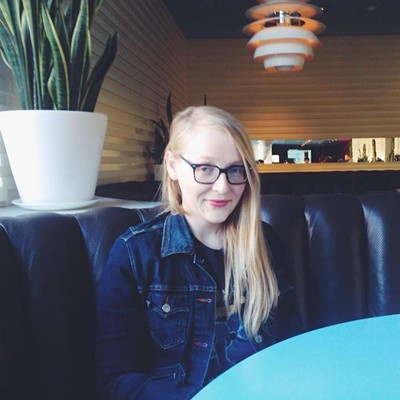When Jackalope Ranch issued a 10-question survey asking Phoenicians (and anyone with an opinion of Phoenix) to sound of on the state of the arts in the Valley of the Sun, dozens provided insights on what's happening in the city's creative realm. We'll present a selection of survey responses here over the next three weeks. Up today is artist James B. Hunt, a.k.a. NXOEED. He's known for hiding things (namely, his art).
See also: Melissa Dunmore on the State of the Arts in Metro Phoenix
1. What are three words that describe the arts in Arizona? Work in progress.
2. Describe your role in the Arizona arts scene (including "observer" -- a very important role!) and how it came to be. I'm a visual artist. I hide my paintings throughout the greater Phoenix area and post treasure maps in random places so that people can go and hunt for them.
3. Who is making the biggest impact on metro Phoenix's art scene and how are they doing that? I think anybody who makes a thing and puts it out there is doing their part. We don't need to be more of what we already are.
4. Where has metro Phoenix made the biggest strides in the arts in the last 10 years or so? I like that artists are putting their work out there. I don't think Phoenix itself deserves any credit for that.
5. What are Arizona's most underused arts resources? Its sidewalks, streets, and vacant lots. You can obtain letters from city attorneys in Mesa, Tempe, Scottsdale, and surrounding cities and towns, stating that you have the right as an artist not only to display, but to sell your "non-utilitarian" works of art (paintings, prints, sculptures, poems) in public spaces without the fear of harassment from authorities, because as an artist, you are elevated to the highest level of First Amendment protection. You can keep those letters on you and wave them in the faces of people who tell you otherwise. You are not able to do this in Phoenix. This is a problem.
6. How can artists and institutions better connect with audiences? Find a space and use it. Anything will do.
7. What are the biggest roadblocks in metro Phoenix's art scene and how can we get past them? We're nomads. We go where anybody'll take us. Every few years, an outside entity comes along, sees the progress we've made and decides to capitalize on it. So we're evicted, bulldozed, or (as in the case of the first Super Bowl that came to Tempe in 1996), given one-way tickets out of town and told never to come back, so that the "people who matter" don't have to look at us. I can't speak for the rest of the community, but I got the message loud and clear twenty years ago. It keeps happening. It doesn't surprise me one bit to see that we're losing Roosevelt Row to outside investors. I'm surprised we've lasted this long, to be honest.
I get past it by going where I'm wanted once it starts happening again.
8. Metro Phoenix's art scene needs __________. what it already has.
9. What can metro Phoenix's art scene learn from other parts of the state -- and country? Stay out of our way.
10. In three years, what three words do you hope describe the state of the arts in Arizona? Safe to create.
See also: The Fight to Keep Downtown Phoenix "Authentic" Is a Fight to Let It Become Something It's Never Been Follow Jackalope Ranch on Facebook, Twitter, and Pinterest.











